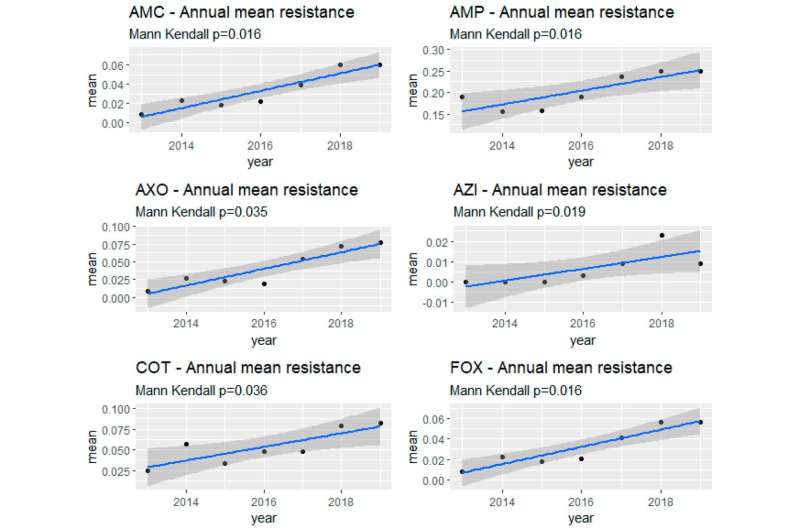This article has been reviewed according to Science X's editorial process and policies. Editors have highlighted the following attributes while ensuring the content's credibility:
fact-checked
trusted source
proofread
Researchers track antimicrobial resistance in E. coli isolated from swine

The spread of drug-resistant microbes has become a global health concern that threatens our ability to treat infections. The widespread use of antimicrobials in livestock, such as swine farms, exacerbates this problem. Therefore, we need surveillance systems to monitor these microbes to support the public health authorities. To this end, researchers have tracked the antimicrobial resistance of Escherichia coli isolated from swine.
Antimicrobials are essential for preventing and treating infections in humans and animals. According to the US Food and Drug Administration, 70% of all antibiotic sales in the US are used for livestock production. However, microbes change over time to combat these chemicals, eventually becoming resistant. As a result, infections become harder to treat. Concerningly, these resistant organisms can spread from farm animals to humans, creating a bigger health crisis.
The researchers focused on E. coli since these bacteria are ubiquitous in the intestinal tract of humans and pigs, and they are good indicators to test whether meat and meat products have been contaminated. E. coli can also acquire and transfer resistance genes to other bacteria in the intestinal tract, making them ideal for monitoring programs of livestock and humans.
"It is important to monitor the emergence of antimicrobial-resistant bacteria in the swine industry because in 2022 the US was the third largest producer and consumer of swine meat and products, after the European Union and China," said Hamid Reza Sodagari, a postdoctoral research associate in the Varga lab. "Although it is a big problem, to the best of our knowledge this paper is the first surveillance study in the US that looks at antimicrobial resistance in E. coli from swine at slaughter."
The study used publicly available surveillance data of cecal samples, which were collected from the intestine after slaughter. The researchers focused on market swine and sows in the US between 2013 and 2019, and used the data compiled by the United States Department of Agriculture Food Safety Inspection Service under the National Antimicrobial Resistance Monitoring System for Enteric Bacteria program.
"Federal agencies often don't have the manpower to carry out such long-term and detailed analyses. Alternatively, for most researchers such studies are challenging because usually they track samples on a smaller scale. In this paper, however, we were able to look at more than 3,000 samples across several years," said Csaba Varga (IGOH), an assistant professor of epidemiology.
Using different statistical methods, the researchers found that since 2013, the number of antimicrobials to which E. coli is resistant has either remained steady or increased over the years. In particular, the resistance to ceftriaxone, an important antimicrobial drug in both human and veterinary medicine, increased from 0.8% in 2013 to 7.7% in 2019. Even though these numbers are not high compared to the resistance to other antimicrobials, the increasing trend is concerning.
"We don't know why there is an increasing trend. It may be caused by mobile genetic elements, which can transfer antimicrobial resistance from one bacterium to another. We need to do further research at the molecular level to understand the reason for the increase," Sodagari said.
"We are not blaming anyone for this problem. Our study is meant to show that there is an issue and that surveillance systems are very important to show the changes in resistance," Varga said. "By gathering this data, we hope that the public health authorities will be able to develop mitigation strategies."
The study "Evaluating Antimicrobial Resistance Trends in Commensal Escherichia coli Isolated from Cecal Samples of Swine at Slaughter in the United States, 2013-2019" was published in Microorganisms.
More information: Hamid Reza Sodagari et al, Evaluating Antimicrobial Resistance Trends in Commensal Escherichia coli Isolated from Cecal Samples of Swine at Slaughter in the United States, 2013–2019, Microorganisms (2023). DOI: 10.3390/microorganisms11041033
Provided by University of Illinois at Urbana-Champaign



















